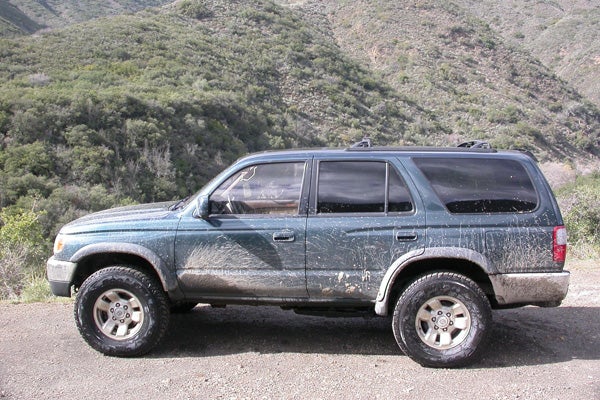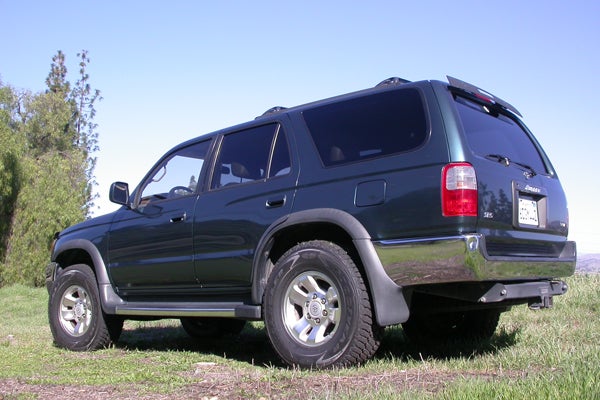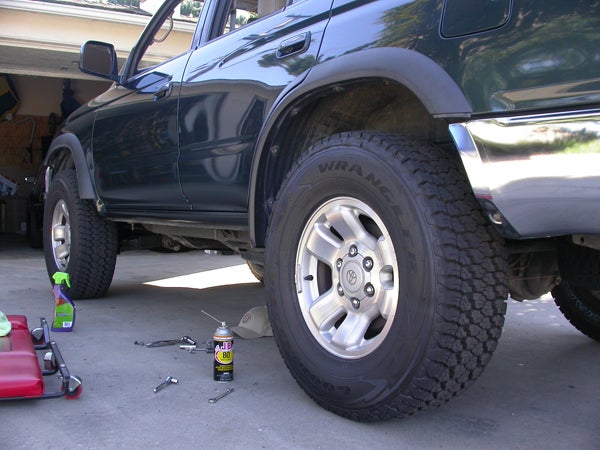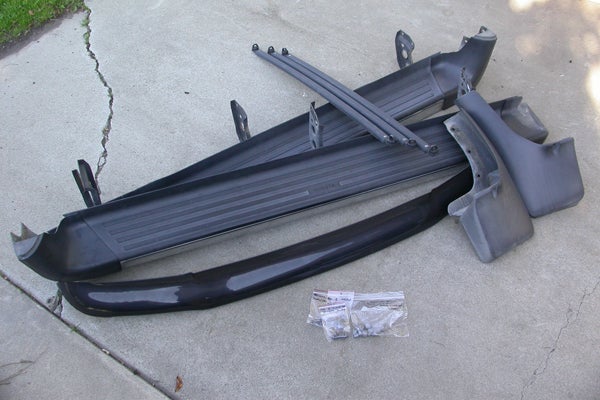
You can’t build a birdhouse with bacon, and it’s really hard to have fun with your shotgun when the clays are made of cardboard. To best satisfy expectations, you must to start as well as you plan to finish. We’re on to our second trail rig buildup (the previous being the Rav4 Trucklet), the second two-track toy and a second run at building a killer backwoods adventure-mobile. This time it’ll be with a more adaptable, more modifiable and more capable truck.
1997 Toyota 4Runner: How Good?
The third-generation Toyota 4Runner was manufactured as 1996 through 2002 models. It’s a collection of well-designed OEM hardware and stock parts that make this truck enormously effective on the trail right out of the box: it features a live rear axle located with a four-link, coil springs all around, cavernous wheel wells for nice stuff, a torquey straight-four or a relatively smooth V6, well-spaced low-range, decent stock ground clearance, a full-length frame, and it has room for gear (and a sleeping bag) in back. This model 4Runner also has decent drive-up angle, is not as big or heavy as a full-size, and it offers Toyota-grade reliability and durability.

All bone-stock and no one cares. Goodyear Wranglers were the only thing we’d touched at the time this picture was taken, but we didn’t have much choice – new rubber was necessary.
But this truck has weaknesses to overcome as well, such as limited droop up front due to the independent front suspension, some historic trans issues with the overdrive slushbox, not quite enough guts from the motor (and a history of floating the heads), crap departure-angle in back with bumpers of dubious strength, plus weak brakes in the front. There’re probably more things to address – but we’re hoping to remedy them in advance of breaking them. We’re still figuring the details out, though, with the help of the huge reservoir of 4Runner information online. What’s funny is that lots of it is in conflict – that’ll need to be sorted out too. People on YotaTech and other boards are nothing if not vociferous. Expect regular lurks into the Toyota webiverse in the process of this process.
PAGE 2
Hello 4Runner, Goodbye Trucklet
Alright, let’s get it out of the way: long live the trucklet. Our last project, the indomitable trucklet (a ’98 Rav4), was a great piece of fun. It was tongue-in-cheek, sure, but it was also far more successful than anyone expected. It was popular with folks in the scene, too. Not surprisingly, though, to make a car-based and fully-independent grocery-mobile truly capable in the rocks and weird stuff would have been a bigger project than the results could justify, so we moved on.
A $3,000 4Runner with a blown transmission was a good place to start.
Once the trans was rebuilt on the back of a favor owed to us, we shortened the familiarization process to get going on the surface-level shortcomings of this absolutely unmodified 4Runner. First things first – tires. The OEM-style high-mileage weenies were freeway-only slackers called the BFG Long Trail, and outside of paved roads named “trail” they weren’t up to the job. To their credit, we took the bone-stock 4Runner to a Thanksgiving weekend in the desert south of Blythe and the BFGs held up (and that is seriously rough country), but off-roading with them devolved into a weekend of pointy-rock paranoia peppered with “Watch it!” and “Dude!” amongst other less savory and more sailor-esque terminology.

About 20 nuts and bolts separated the running boards, mud flaps and a few other useless parts from this truck in about an hour.
We hunted down a set of Goodyears we’d tested earlier in the year – a version of the Wrangler that was full of Kevlar, called the Silent Armor – and put four 265/75/16s on the factory split three-spokes for about $200 a corner. At stock ride-height, they fit without travail and have so far worked admirably in the tough stuff with no issues – they don’t touch anything in the wells at full compression. They’re also a lot quieter than your standard-issue bogger, though admittedly not as aggro. Once we get the suspension sorted out, we’re going to experiment with even more Kevlar and try Goodyear’s reputedly bulletproof MT/R Kevlar, wrapped around a set of something steel, like a Pro-Comp Rock Crawler. Some 17-inches would be cool.
Doom on GingerbreadBeyond installing the right shoes on the factory split-three 16-inches (those Wranglers have proven suitable for quality off-roading when aired down, despite being mild enough for regular pavement use), there was the problem of gingerbread. Okay, if you don’t get it, “gingerbread” is one of 100 nicknames for the useless stuff the factory or dealer will bolt on to your vehicle to add “style” or “flair,” all of which actually means “weight” and “clutter.” Loaded down for the sad life of an SUV, this 4Runner had a full suite of running boards and mud flaps and ding bats, excess metal and plastic that would be in the way of rocks close to the trail, and that’s when it wasn’t busy being in the way of the tires or hitting your shins.

Hey look, 60 pounds of crap. There’s a bug deflector in there, too.
Larry Shinoda – the Ford designer responsible for the Boss 302 Mustang – was a lifelong opponent of non-functional crap, ie: gingerbread. If it didn’t serve a purpose, he got rid of it, and that was part of the reason the Boss 302 was so cool. When our dust cleared and unbolting was through, we’d peeled about 60 pounds of useless crap off the truck (we actually weighed it!), and Mr. Shinoda would have been proud. The castoffs included the ankle-biting, rock-detecting running boards and the tire-grabbing front and rear mud flaps (nice when you have paint you’re worried about, but pointless on a 160,000-mile 4Runner in San Diego). This strip job is the sort of self-inspired simplistic maneuver that all of you Toyoters are supposed to figure out for yourselves: weight reduction (sans strength reduction) is always a good thing.
Impending 4Runner Buildup
Keep your eyes here: more excellent 4Runner things will be happening shortly. We’re sorting out the details of the famous Tundra front brake swap, the as-famous Tundra front suspension lift (and what rear hardware to match with it), plus taking a run at renaming this truck a 4Tundra. We’ll locate and install a proper locker in back (perhaps the OEM E-Locker?), chase maintenance items left wanting and attack all the other sundry bits necessary to getting this 4Runner right for the rocks. Stay tuned.


 Your Privacy Choices
Your Privacy Choices